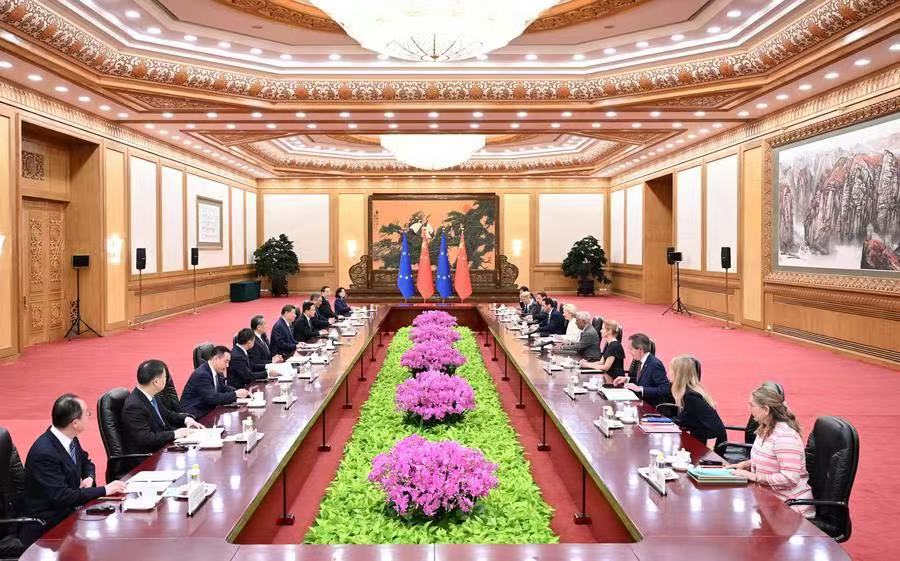Observations on the EU-China Summit

Source: Xinhua/Li Xiang
Commentary by Li Yang, Executive Director, ICES
July 28, 2025
The highly anticipated EU-China summit has concluded in Beijing. In contrast to the growing pessimism during the run-up to the summit, the meeting was a modest success. Although EU-China relations are not determined by the policy shifts of the US, uncertainties and distrust between the EU and China were exacerbated under the shadow of the latest US challenges. Further, the two sides need more effective dialogue to bridge the gaps in their approaches to managing the bilateral relationship. The summit could help the two sides advance their ties on a more realistic and pragmatic basis.
On the 50th anniversary of their diplomatic relations, the highly anticipated EU-China summit
took place in Beijing. In the run-up to the summit, the expectations were increasingly low, at
least as viewed from Brussels. This pessimism
seemed not to be shared in
Beijing, where some prominent
scholars
thought that the attitude toward the summit should be calm and rational, without expecting the
meeting to solve all the problems. A closer look revealed that these two views were in fact the
same, differing only in their perspective on whether the glasses were half empty or half full.
The summit on July 24 proceeded smoothly. Although a positive reset of the
relationship did not happen, there were no negative surprises either. Both sides deemed the
meeting excellent, according to the
readouts
and
statements.
The EU leaders described the dialogue as constructive and pragmatic. An
EU-China joint statement on climate
was published as scheduled. Further, an
upgraded
supply mechanism was agreed upon to expedite the export of critical raw materials. In the meantime,
as expected, there was no tangible breakthrough on contentious issues, including trade imbalances,
overcapacities and the war in Ukraine.
The events before and during the summit
suggested that shifts in both transatlantic ties and US-China relations do not necessarily
lead to an EU-China rapprochement. The overly
high expectations
on EU-China alignment, as an immediate result of US President Donald Trump’s return to the White
House, were partly a cause for the subsequent watering down of the initial enthusiasm toward the
relationship.
China is pleased to see the EU seeking strategic autonomy, but it does not believe that an EU- US “divorce” is imminent. The EU is strengthening its
role as an independent geopolitical actor, with the key message being that the
bloc needs to address challenges from the US and China
simultaneously. The strategic ambivalence between the EU and China is expected to persist in the
near future.
However, the EU-China relationship is still overshadowed by the
pressures or challenges from the US, as both sides are preoccupied with their tariff
negotiations with the Trump administration. While now preliminarily resolved between the EU
and US, the ever-changing scenarios of these trade talks created significant uncertainties for
EU-China relations. Several European observers attributed the hardening tones of President von
der Leyen toward China and the souring of the relationship during the latest months to
a weakening of political will
from the Chinese side to make meaningful concessions or compromises for solving the major pending
issues between the EU and China, particularly after China successfully entered into a
truce
in the tariff war with the US in Geneva in May 2025. The
repeated calls
for the EU to use EU-US cooperation as a bargaining chip in its deal- making efforts with China
also roused China’s skepticism toward the EU’s intentions. These perceptions, or misperceptions,
toward each other had a mutually reinforcing effect exacerbating the distrust between the EU and
China and casting a shadow over the summit and, if not addressed, possibly even over the future
relationship.
The summit also highlighted a discrepancy between European and
Chinese approaches to managing their bilateral relationship. China appears to believe that the
current bilateral issues are not the result of a clash of fundamental interests, but instead
of
differing perceptions and narratives.
As a result, the Chinese side seems more intent on dispelling misperceptions, making clarifications
and establishing long- term guidance. By contrast, the
EU pushed harder on concrete progress or real solutions, implying that mutual trust will only be incrementally built through tangible results. This
gap, although deep-rooted in their different ways of thinking, could be narrowed by making a
sincere effort to truly understand each other, thereby leading to more effective communication
between the EU and China.
Overall, the summit can be considered a modest success.
Both sides had the opportunity to present their demands to the other and to make their
arguments heard. While this was not enough to reset the relationship, it may lay the
groundwork for advancing them on a more realistic and pragmatic basis. Now is the time to
closely follow what unfolds in the aftermath of the summit.